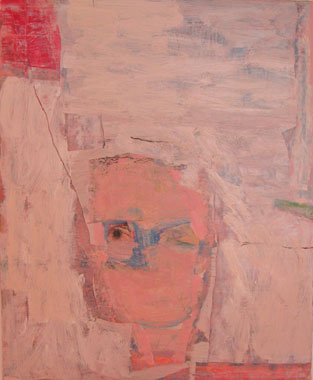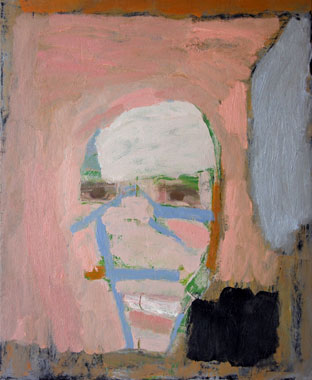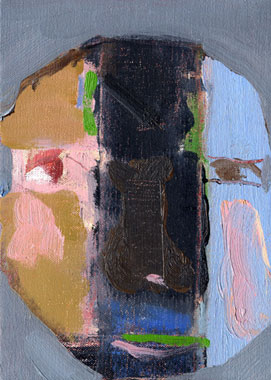 |
Paddy McCann: I was somewhere else , oil on canvas, 2004, 61 x 50 cm; courtesy the artist |
During late July and August 2004, Gallery Two of Belfast’s Fenderesky Gallery housed seventeen paintings in six sizes, the smallest 22 x 16 cm, the largest 146 x 114 cm, all oil on canvas.
Their titles, like Latest face, Red door, Hand behind back or Eye lip, were more or less descriptive, whereas other titles, like I was somewhere else, After we meet and Kiss before sleep, showed a reluctance to fit the retinal input. Consequently, looking for a dominant and shared visual key to the meaning of each became a complex search, enjoyable and difficult in equal measure.
One iconic detail quickly became omnipresent – an eye, the eye, one eye. It was not just an eye in a face – expected and tolerated as part of a portrait, with all the attendant possibility of vanity and connection to the myth of Narcissus. It was not a polished, looking-glass, reflecting iris – it was a knowing eye, and a ‘blind’ eye still looking out from the canvas, dissolved into a one-colour circle, which in its perfection lost its life.
So may he himself love,
And
Not gain the things he loves [1]
Not being able to find consolation, Narcissus died of sorrow – a feeling that blinds the pupils of several of the eyes in McCann’s paintings. They reminded me also of Velásquez – his power of connecting observation with mystery.
The hypnotic power of the gaze was still there, undermined not by the past or present, but, hilariously and tragically, by eternity. I felt the weight of myth in most of the painted eyes. Orpheus looked back, not respecting Hades’ warning, and Eurydice slipped back into the netherworld. McCann does not issue any warnings. It is not clear what we lose if we do or do not obey the unknown stipulation. It will become clear later on.
 |
Paddy McCann: Here, oil on canvas, 2004, 61 x 50 cm; courtesy the artist |
McCann has painted one-eyed faces before, his own too, in a softly political comment on the camouflage of identity in television news.
Now – the consistent, relentless presence of an eye forges ambivalence in the paintings’ relationship to McCann’s subject matter. This I cannot describe simply; it is a mixture of his experiences as a man and as an artist, as a citizen and as a father, as a practical man and as a poet, and as a friend of persons who have died and of those still living; a mixture with the "who am I" question as a philosophical extension of simply being. However, McCann resists ideology and rival theories of art, with the exception of deeply private choices. He weaves a complex questioning of identity and imagination, practical reason and painting, all guided by a severe selection of a few recognizable motifs. The dominant one is his search for the ethos of truth in painting. His resonance with Anselm Kiefer provides some keys to the way he goes about this. I have already mentioned the ambivalence of details; this combined with humour spiked with hidden pain echoes Dance of death by Berndt Notke and Hans Holbein.
Contrary to that tradition, McCann rejects the pathos and the comforts of multitudes. His is an individual’s anguish, harvested in all those moments, short or long, when we are utterly alone. Like Kiefer, McCann paints a disembodied head, and unlike Kiefer, he does not fall into allegory (I have in mind, for example, the female head, which bleeds from a neck wound, staining the snow below, in Kiefer’s The winter landscape, 1970, or portraits of known persons with their names inscribed around their heads, placed above the image of the horse in Ride to the Vistula, 1977-8).
McCann prefers that the heads and the lone eye both be connected to the afterlife and be palpably here and now. If this tendency is diminished in some of the paintings in this exhibition, it only makes way for the painter’s attentive observation of a fragment of the world, like the façades of the houses visible from his studio window. His gaze is presented as a natural, not cultural idiom, and the architectural forms twist and swarm in a denial of any stability or right angle. The gestural strokes allude to some aggression – at least fleetingly. Whereas pain is connected to eternity, aggression is sentenced to a temporary existence.
While he captures a sense of time, McCann represents his subject as extended in time, even if, paradoxically, he paints a particular moment – like an upright standing male figure with hands behind his back, turning his profile to us as if ready to leave to the right of the frame. In contrast, in Leaving the standing figure is not about to walk; instead the body dematerialises behind the red and green strokes.
 |
Paddy McCann: Hands behind back, oil on canvas, 2004, 35 x 20 cm; courtesy the artist |
I mentioned his search for truth in painting, which in these paintings connects to the orphic principle, the belief that art can prevent people, as it did the Argonauts, from being lured by bad forces, that beauty breaks the law of death, that stones and branches refuse to hit Orpheus, and that his disembodied head floating down the river was still singing. The ancient philosophers understood that deepest truth could not be put in ordinary language; our contemporary culture has chosen more often than not to believe otherwise. Poets know this. McCann knows it too and elects to be in that minority that might read Plato’s Republic . This characteristic is connected to unmovable honesty and also to an ambition to succeed. In relation to a viewer it is a charitable and generous idea, for the painter, however, it is anything but. The dynamics of the construct combining honesty and ambition are difficult, and at times uncomfortable to work with
Plato’s Myth of the cave is about truth, about the light, or lack of it, in people. In the cave people are chained so that they cannot move, they can only "see before them."[2] Seeing is thus given the majestic right to connect with ultimate reality, the light of the real world at the mouth of the cave, the sun. There is another light in the cave, a fire "blazing in a distance"; it makes shadows of the men passing along the wall carrying statues and figures…
Like ourselves…and they see only their own shadows…which
The fire throws on the opposite wall of the cave.
To see one’s shadow is meant as an absence of knowing who one is. What kind of world does ignorance create? At present we know the answers to this question only too well.
To the prisoners, truth is nothing but the shadows of images. What if the prisoners were released, allowed to move, to go to the mouth of the cave?
Socrates is made to say…
At first, when any of them is liberated and compelled suddenly to stand up and turn round and walk and look towards the light, he will suffer sharp pains, the glare will distress him, and he will be unable to see the realities of which in his former state he had seen shadows.
There is no need to agree with all of Plato’s system of truth; nevertheless the two ideas I highlighted are with us here and elsewhere: the shadows believed to be truths, the need for turning round to question shadows and their opposites, and with it the pain of recognition.
 |
Paddy McCann: Kiss before sleep, oil on canvas, 2004, 22 x 16 cm; courtesy the artist |
In these paintings the images are also shadows, not only of truth but of the quest for truth; the stage before you separate yourself from received consciousness and aim at the best you can do to achieve increased consciousness, increased spiritual riches. When you are at the point of almost knowing that you are that consciousness and those riches.
Plato pointed out that the prisoners have to be "reluctantly dragged" and "held fast" to approach light – i.e. consciousness.
McCann’s images have the power to keep me out of that cave, at least while I am seeing them. Sight turned in the right direction is clearly the condition encouraged by Plato and disobeyed by Orpheus.
Slavka Sverakova is a freelance writer on visual art.
[1] Ovid, Metamorphoses, Book III, Narcissus and Echo
[2] This and all subsequent quotes from The Myth of the cave in Plato (360BC), The Republic, Book VII, 514a – 519a